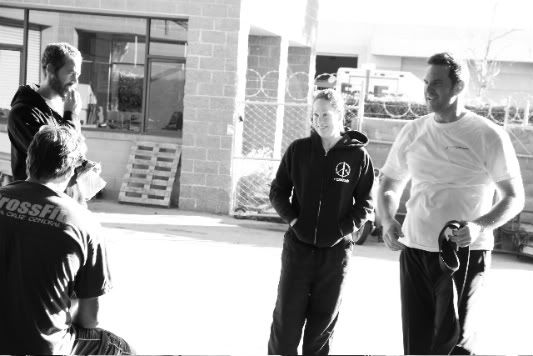Resting is Training
/ Some of the crew.
Josh is fast - :26 second time of the day
Some of the crew.
Josh is fast - :26 second time of the day
So the answer to last nights little question is "after", as most of you I'm sure guessed. The point of the question was to drill home the fact that you do not get stronger, faster, better during the workout, you get stronger, faster better during the recovery from the workout. There is an extremely valuable model to understand, not just for training effectively but for any life stressor, and that is Hans Selye’s General Adaptation Syndrome theory, proposed in 1936. There are three stages in this model. First there is the shock and alarm phase. Keeping it relative, this could be a 5 x 5 Back Squat, 5k run, Fran and anything in between. All of these actions are stressors to your system, which can be beneficial. The next stage is the not so understood but very important adaptation phase. This is where you rest/recover and all favorable adaptational processes occur (this is what sprung the previous nights question). The last stage is exhaustion. Unlike the first two stages, which are completely fine and absolutely necessary for driving progression, this stage we DO NOT want to be in. It is called overtraining. This usually happens when stage two is not allowed enough time to complete its processes and another stressor (stage 1) is added. In practical terms not giving your body enough rest. If stage three is avoided, then adaptation is allowed to occur and supercompensation is realized, meaning you’ve gotten stronger, faster, better. As an example; If you are eager to get better at handstand pushups it may seem like a good idea to do them everyday. This does not necessarily mean you will overtrain, but it does mean you are not giving your body enough rest to make the most beneficial and effective adaptation it can, which decreases performance. So how do you know how long to, how much to, and when to rest? Everyone is different, there is no one size fits all training program. But there are obvious markers to keep track of to make sure you are not in stage three. First, you HAVE to keep a log of your workouts. If you can’t find a way to do every one, then make sure you are tracking your strength lifts, because if they decrease at all, overtraining is possible (it must be understood that if you don’t back squat for 5 months, come back and your back squat went down that that is not overtraining, that is detraining, completely different and ok). Pay attention to your workout times, if they are slower without any other logical explanation, you may be overtraining. The next one is a tough one, injury. It can happen to anyone, anywhere for any reason. But if they happen seemingly all too often in places they weren’t before, and your strength numbers are down, I’ll give you one guess. Another important factor to consider is your energy and how stress ties in to that. If you find your energy is way lower than it should be, it may mean too much stress (this can take many forms e.g. not enough sleep, inadequate food intake, too much training etc.) and not enough rest. Stress and how it relates to training is very complex. Crossfit workouts are extremely potent. This is an amazing quality, as adaptations across the board can be stimulated in less than 5 minutes, it simply can’t be beat. This potency also requires some potent rest, meaning resting with enough frequency (days/week) and magnitude (time) [current training status, age and who your parents are a few more variables to the equation, everyone is different]. Resting and recovery from a workout can be supported by handling as many levels of stress outside of Crossfit as possible e.g. eating enough, eating well, sleeping enough, sleeping well, social support, positive thinking, good digestion, meditation (that’s right), avoiding toxins, no coffee, no caffeine, on and on. Obviously these supporting factors are not required to do Crossfit or even benefit from it, or we’d be out of business. The point is to understand a little better what stress is, how it can be manipulated for our benefit (as simple as training hard and resting enough), how each individual needs to be approached accordingly, and what to look for in order to avoid overtraining. It is one of the hardest things in training to understand and appreciate. Resting is training.
Side note - It is good to say that the gym is in good standing in this regard, so worry not. This is just information to try and make sense of some things and help make training more effective and efficient going forward. Ask questions! Especially if you are more confused now than ever.
Workout:
1 minute Handstand Push Up max - 1 minute Handstand hold - rest
:45 second Handstand Push Up max - :45 second Handstand hold - rest
:30 second Handstand Push Up max - :30 second Handstand hold - rest
then,
3 rounds:
22 KBS
15 Burpees
Programming: Gary
Christmas party Friday December 9th, at 6:30p.m. The Point Chophouse, BE THERE!


